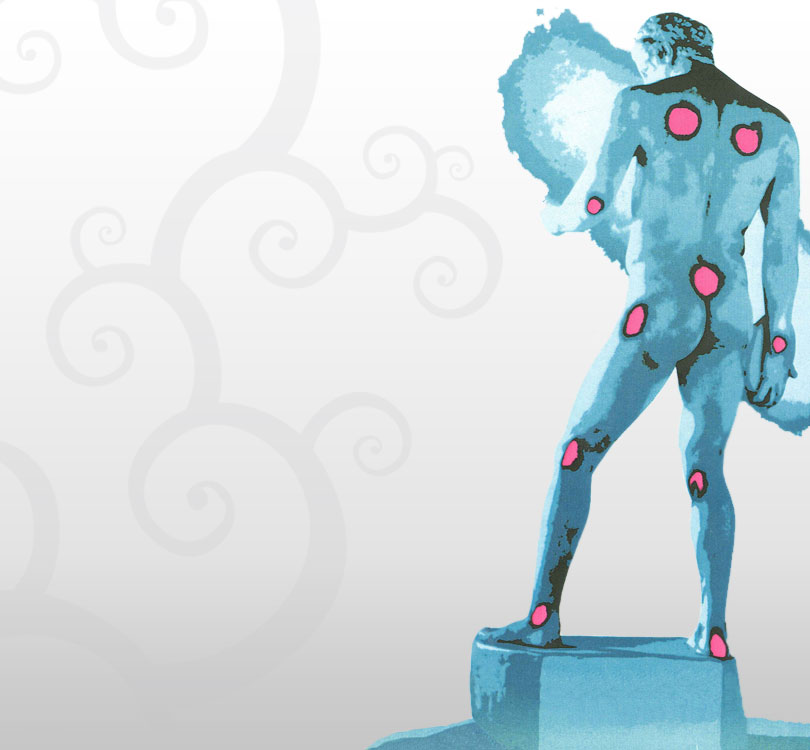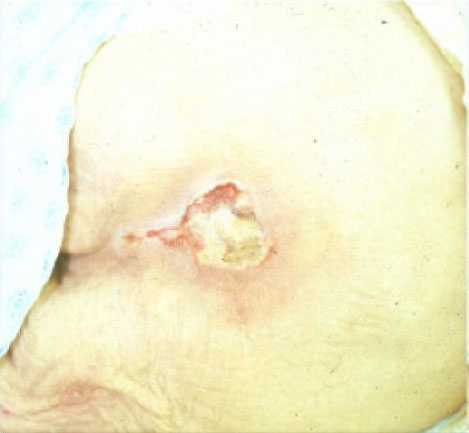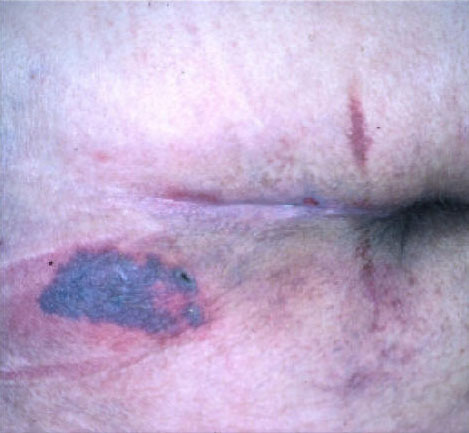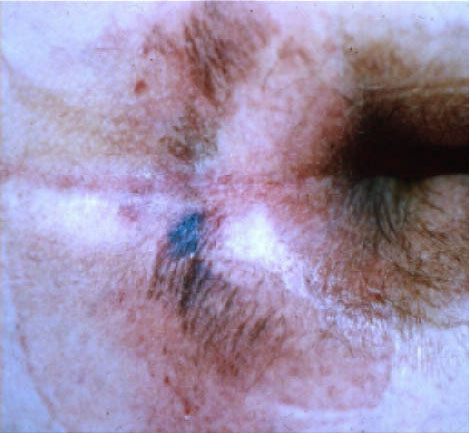
Information for use in indentifying, treating and understanding the kennedy terminal ulcer

Questions & Answers
A Kennedy Terminal Ulcer is a pressure ulcer some people develop as they are dying.
It usually presents on the sacrum.
It can be shaped like a pear, butterfly or horseshoe.
It can have the colors of red, yellow, black or purple.
The borders of the ulcer are usually irregular.
It has a sudden onset.
The two statements you hear most are::
1 “Oh, my gosh, that was not there the other day.”
2 “I worked Friday, it was not there then, I was off the weekend and when I came
back on Monday there it was.
It usually starts out as a blister or a Stage II and can rapidly progresses to a Stage III or a Stage IV. In the beginning it can look much like an abrasion as if someone took the patient and drug his or her bottom along a black top driveway.
It can become deeper and starts to turn colors. The colors can start out as a red/purple area then turn to yellow and then black.
They can start out larger than other pressure ulcers, are usually more superficial initially and develop rapidly in size, and depth and color.
Treatment for a Kennedy Terminal Ulcer is the same as for any other pressure ulcer with the same characteristics. What you see is what you treat. When it is in the blanchable/or non-blanchable intact skin stage the goal would be to relieve the pressure and protect the area. When it becomes a Stage II or a partial thickness ulcer usually there is not a lot of drainage and a thin film, hydrocolloid, foam or gel may be indicated. When it is a full thickness wound, Stage III or IV depending on the amount of drainage you could use a hydrocolloid, foam, gel, or calcium alginate. If there is necrotic tissue slough (yellow tissue) or eschar (black, brown, beige or tan tissue) you may want to use an enzymatic debriding agent. If it becomes clinically infected you may want to consider a dressing with silver.
Further research needs to be done on this subject. However, one idea is it may be a blood perfusion problem exacerbated by the dying process. The skin is an organ, just like the heart, lungs, kidneys, lungs and liver. It is the largest of the body organs and is the only one that is on the outside of the body. It can reflect what is going on inside the human body. One theory is as people are approaching the dying process the internal organs begin to slow down and go into what is thought of as multi-organ failure. This is where all the organs start to slow down and not function as efficiently as previously. No particular symptomatology may be detected except the skin over bony prominences starts to show effect of pressure in a shorter time frame. Where as turning a patient every two hours may be enough in somewhat of a normal situation it now may cause superficial tissue damage.
Yes, and no.
The majority of them do not. It is something that is generally thought to be terminal. However, it has been known for a patient that was terminal or at the end of life and the patient or family decided they did want intravenous or tube feeding intervention along with other appropriate modalities to change their mind and decide they did want all available interventions. At that point I have known of patients to have this phenomena reversed.
In March of 1989 the National Pressure Ulcer Advisory Panel put together their first conference in Washington D.C.. The conference was to help determine how many pressure ulcers there were (prevalence) and could you predict who was going to get them.
Further research needs done but it tends to be a geriatric phenomenon. It does not seem to be prominent in pediatrics. It is reported frequently in hospice patients
In our experience at the Byron Health Center in Fort Wayne, Indiana, a 500-bed long-term care facility at that time, presented as a subdivision of the Kennedy Terminal Ulcer. It presents a little different and has a quicker time frame. It can come on quickly, sometimes in a matter of hours. It comes on as little be-be spots that are black. They tend to look like a speck of dirt or dried bowel movement most caregivers tend to try to wash away, finding out it is under the skin and not on the skin. These can look like suspected deep tissue injuries. As the hours progress it becomes larger and can in a matter of hours become almost the size of a quarter, fifty-cent piece or silver dollar. These can look like someone colored the skin with a black or purple marker. Presenting as a black flat type blister with intact skin presenting in a unilateral location. The usual story is the patient got up in the morning the skin was examined by the nurse aid and the skin looked normal and was intact with no discoloration. At 3:30 PM when the patient was placed back in bed the skin shows this blackened discoloration. (Thus the name: 3:30 syndrome.) When the nurse comes to examine the discolored skin it is difficult to believe it actually was not here in the AM and is as large as it is 6-8 hours later. The life expectancy of the 3:30 syndrome presentation of our patients was within 8-24 hours.
It was named by the Medical Director of the Byron Health Center is Fort Wayne, Indiana, Dr. Stephen Glassley. He termed it “The Kennedy Terminal Ulcer”. Naming it after the first Family Nurse Practitioner, in Fort Wayne, Indiana, Karen Lou Kennedy. Karen began employment at the Byron Health Center in 1977 and in1983 started one of the first Skin Care Teams in a Long Term Care facility. Record keeping was initiated indicating some patients developed pressure ulcers with similar characteristics(see photos) that went on to die in a short time frame.
As the data was reviewed a pattern developed as to the characteristic and time frame from onset to death. This data was reviewed by the medical director, Dr. Stephen Glassley and the attending physician, Dr. Delores Espino, thus naming it the “Kennedy Terminal Ulcer”.
This was first described in modern literature by Karen Lou Kennedy in 1989 in Decubitus (now know as Advances in Skin & Wound Care) Vol.2, No,2, May 1989. p.44-45
However, in about 2002 Dr. Jeffrey M. Levine, MD, AGSF, found a long lost textbook published in 1877 by professor Dr. Jean-Martin Charcot called Lectures the Diseases
of The Nervous System. In this textbook were hand drawn pictures and descriptions of the Kennedy Terminal Ulcer and the three thirty syndrome. The term used by Dr. Charcot was Decubitus Acutus (Acute Bed-Sore) described as the 3:30 syndrome by Kennedy and Decubitus Ominosis described as the “Kennedy Terminal Ulcer” at the Byron Health Center.
Dr. Charcot was a French neurologist considered the father of modern neurology and the first professor of diseases of the nervous system regarded as one of the most important researchers in the field of clinical neurology of the 19th century.
Dr. Charcot contributions to neurology were describing a range of neurological diseases including multiple sclerosis, lateral amyotrophic sclerosis, Parkinson’s disease and Gilles de la Tourette syndrome to name a few. Other important contributions by him have been forgotten.



Photos
The last 2 photos show how the Kennedy Terminal Ulcer looks in the first 4-8 hours of development
Testimonials
Dear Karen,
Thank you so much for the information you sent on the Kennedy Ulcer, it was very helpful. Our resident passes away this morning but the family was better prepared. Thanks to you.
Sincerely,
Kathy M. Hutchins, RN
Assistant Administrator
Morehead Nursing Center
Eden , NC 27288
Dear Karen,
One of the most difficult times a family can experience is when they must admit that they can no longer care for a loved one at home. The realization that someone you love requires more care than you can provide or that the fragile health goes beyond the families capabilities often results in grief and loss that is overwhelming. A few weeks ago one of our resident’s health began to decline and during routine assessment the nurse identified an area as being a Kennedy ulcer. I wrote to you and asked if you could fax me any information on the Kennedy ulcer. We were fortunate to attend a conference where the Kennedy ulcer was discussed and the participants brought the information back and shared it with our entire nursing staff.The information you sent I shared with our family members, they were very appreciative of the information. The identification of the ulcer and the ability to share the information with the family enabled them to be better prepared for the following weeks. Our resident passed away less than three weeks after the ulcer was identified but the family took time to share with me that it meant so much for them to be better prepared, it allowed them to experience closure and know that they had helped make her last days comfortable. During this time we had our annual DFS survey and the RN Surveyors had not heard about the Kennedy ulcer! We had an opportunity to share this information with them as well! Our philosophy here at Morehead Nursing Center is to provide our residents and families with information and knowledge that is needed to make good decisions, open communication is vital to providing good care. Thank you again for all of your help.
Kathy M. Hutchins, RN
Assistant Administrator
Morehead Nursing Center
Eden , NC 27288
I am currently a senior nursing student at the State University of New York at Buffalo. I first heard of the Kennedy Terminal Ulcer on a listserv I was on for a class project. Never hearing of the KTU before, I started to do research on it. I found that it was a breakdown of the skin. However, not in the form of a pressure ulcer, but in the sense that the skin has stopped working prior to death. I have not had the chance to see this on an actual patient, but I have seen pictures of the ulcer. I am sure that theknowledge I have gained about the KTU will help me while practicing in the future. I will be prepared to teach my colleagues about this uncommon skin breakdown. I have found, in talking with fellow students, faculty, and nurses in practice, that many health professionals have never heard of this.I think it is important to educate health professionals about the KTU. If the breakdown is a precursor to death, knowing exactly what it is when it appears can help to identify the patient’s last days. It will also help if nurses can differentiate between the KTU and a decubitus ulcer. Decubitus ulcers can cost institutions millions of dollars per year. There could be many KTUs going misdiagnosed as decubitus ulcers. I believe it would benefit all parties involved to educate health professional about the Kennedy Terminal Ulcer.
Melissa Scheib
University at Buffalo
School of Nursing
NSO Recording Secretary
[email protected]